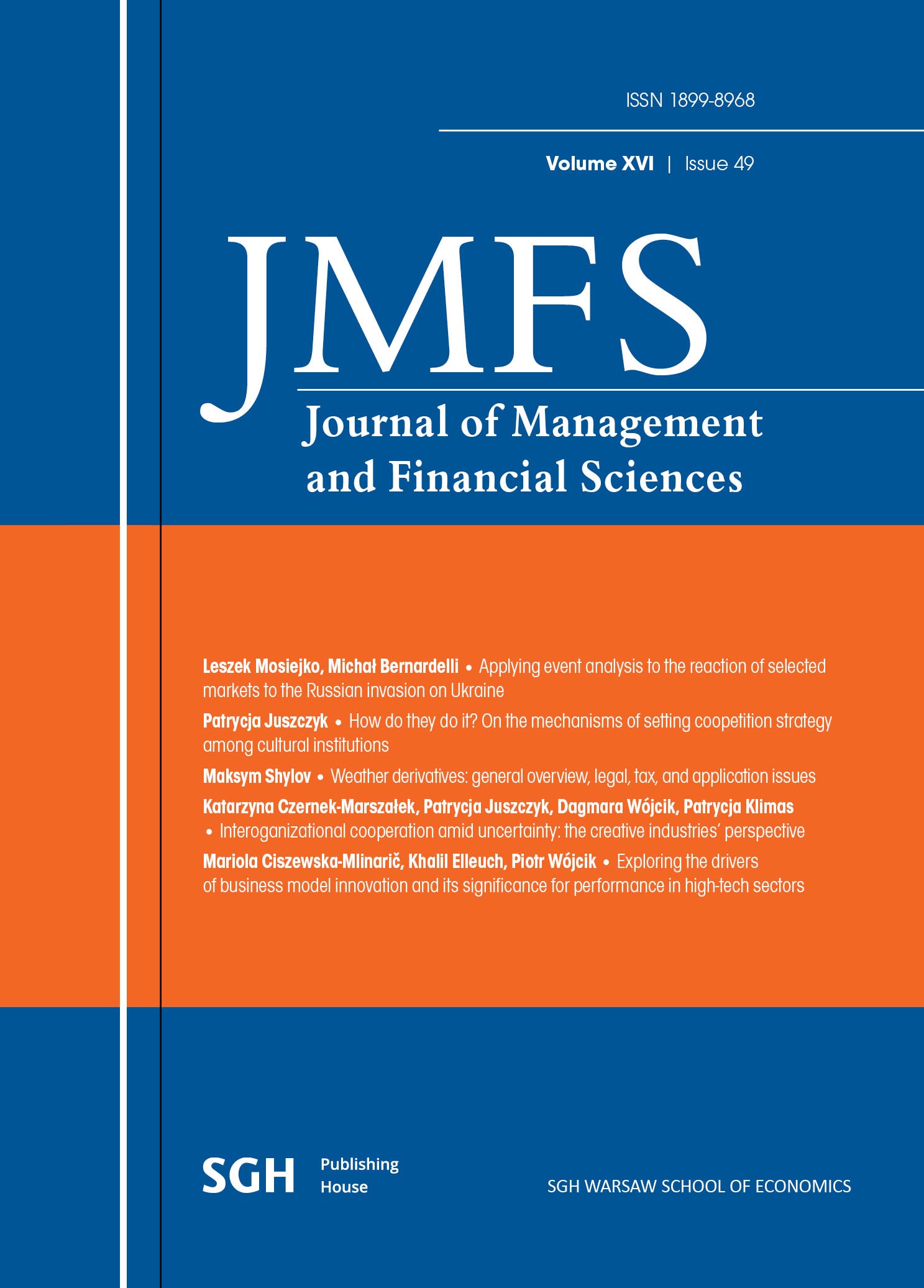Weather derivatives: general overview, legal, tax, and application issues
Main Article Content
Abstract
Weather derivatives are exchange traded (ETD) or over-the-counter (OTC) call to option or swap contracts that are triggered in the specified weather event. Nowadays, acute weather events lead to increasing popularity of such risk hedging instruments. In this article the author presents a brief overview of the nature of weather derivatives, their applicability in various industries, available information on traded volumes, legal framework, taxation, pricing and basis risk, impact on financial resilience of investors. Comparing to the US market, weather derivatives are still not so commonly used in the EU. On the other hand, the obligatory implementation of new EU corporate sustainability standards and the underling TCFD (Task Force on Climate-Related Financial Disclosures) methodology will definitely increase weather risk awareness at least among large and public listed companies. Therefore, the growth of the demand for weather risk transfer tools is expected. In conclusion, next steps should be taken towards the improvement of the functioning of weather derivatives markets in response to the continuing trend of climate change.
Downloads
Article Details

This work is licensed under a Creative Commons Attribution 4.0 International License.
References
Adam-Müller, A. F. A., Nolte, I. (2011). Cross hedging under multiplicative basis risk. Journal of Banking & Finance, 35 (11), pp. 2956–2964. DOI: 10.1016/j.jbankfin.2011.03.022
Alexandridis, K. A. (2013). Weather derivatives. Modeling and pricing weather-related risk. New York, NY: Springer.
Aydin, C, (2019). Pricing of Weather Derivatives. Czech Technical University in Prague.
Bakovic, T., Petijak, K., Štulec, I. (2016). Effectiveness of weather derivatives as a hedge against the weather risk in agriculture. Agricultural Economics (Zemědělská ekonomika), 62 (8), pp. 356–362. DOI: 10.17221/188/2015‑AGRICECON
Barbi, M., Romagnoli, S. (2018). Skewness, basis risk, and optimal futures demand. International Review of Economics & Finance, 58, pp. 14–29. DOI: 10.1016/j.iref.2018.02.021
Basel Committee on Banking Supervision (2018). Reporting guidelines for amounts outstanding at end-June 2019 for non-regular reporting institutions.
Basel Committee on Banking Supervision (2021). Climate related risk drivers and their transmission channels.
Bellini, F. (2005). The Weather Derivatives Market: Modelling And Pricing Temperature. Lugano, Switzerland: University of Lugano.
Blom, J. E. (2009). Hedging Revenues with Weather Derivatives. A literature review of weather derivatives. Norges Handelshøyskole.
Chapelle A. (2019): Operational Risk Management. Best Practices in the Financial Services Industry. United Kingdom: John Wiley & Sons, Ltd.
Climate-Related Market Risk Subcommittee (2020). Managing Climate Risk in the U. S. Financial System.
Cui, K. (2014). Weather Derivatives: Modelling, Pricing and Applications. University of Calgary.
Elabed, G., Bellemare, M. F., Carter, M. R., Guirkinger, C. (2013). Managing basis risk with multiscale index insurance. Agricultural Economics, 44 (4–5), pp. 419–431. DOI: 10.1111/ agec.12025
Gatzert, N., Kellner, R. (2011). Risk management using index-linked catastrophic loss instruments. Zeitschrift für die gesamte Versicherungswissenschaft, 100 (1), pp. 141–151. DOI: 10.1007/ s12297-010-0127‑x
Hokkanen, M. (2021). Derivatives and the European VAT System, 2021.
Hoornaert, A. (2017). Hedging Weather Risk Using Weather Derivatives. Ghent University.
International Organization for Standardization (2018). International Standard ISO 31000:2018. Risk management – Guidelines.
Mentel, G., Bilan, Y., Szetela, B., Mentel, U. (2021). Weather Derivative Instruments. Property Analysis of the Basic Instruments. Economic Computation and Economic Cybernetics Studies and Research, 55 (2/2021), pp. 79–98. DOI: 10.24818/18423264/55.2.21.05
Ministry of Finance. Republic of Slovenia (2022). Taxation in Slovenia.
Perez-Gonzalez, F., Yun, H. (2013). Risk Management and Firm Value: Evidence from Weather Derivatives. The Journal of Finance, 68 (5), pp. 2143–2176.
Silveira, F. A., Parodi de Oliveira, C. S. (2023). A blockchain-based platform for trading weather derivatives. Digital Finance. DOI: 10.21203/rs.3.rs-1891762/v1
Špička, J. (2011). Weather derivative design in agriculture – a case study of barley in the Southern Moravia Region. AGRIS on-line Papers in Economics and Informatics, 3, pp. 53–59.
Till, H. (2014). Why Haven’t Weather Derivatives Been More Successful as Futures Contracts? A Case Study. Journal of Governance and Regulation 4 (4).
Working Group II Contribution to the Sixth Assessment Report of the Intergovernmental Panel on Climate Change (2022). Climate Change 2022: Impacts, Adaptation and Vulnerability.
Yu, Jisang; Vandeveer, M., Volesky, J. D., Harmoney, K. (2019). Estimating the Basis Risk of Rainfall Index Insurance for Pasture, Rangeland, and Forage. Journal of Agricultural and Resource Economics, 44 (1).
Online sources:
https://iclg.com/practice-areas/derivatives-laws-and-regulations/germany
https://www.ey.com/en_gl/tax-alerts/italian-tax-authorities-provide-clarifications-on-vattreatment-
of-derivatives
